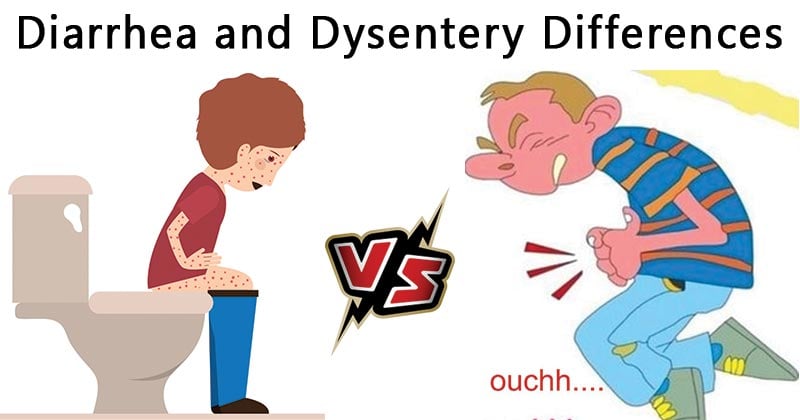Interesting Science Videos
Differences between Diarrhea and Dysentery
Diarrhea and dysentery are two distinct medical conditions which are often used synonymously.

However, both the terms and these clinical conditions have clear differences as follows:
S.N. |
Character |
Diarrhea |
Dysentery |
| 1. | Definition | Diarrhea refers to a condition that involves the frequent passing of loose or watery stools (atleast 3 times a day). | Dysentery is an intestinal inflammation, especially in the colon, that can lead to severe diarrhea with mucus or blood in the feces. |
| 2. | Stool type | Watery stool with no blood and mucus. | Mucoid stool that may be accompanied by blood. |
| 3. | Affects | The small bowel. | Affects the colon. |
| 4. | Target cells | Diarrheal infection targets only intestinal lumen and upper epithelial cells. | Dysentery not only targets upper epithelial cells but colon ulceration also results. |
| 5. | Cell death | There is no cell death in diarrhea and the infection is only caused due to the release of toxins by an infecting agent. | When a person gets dysentery, the upper epithelial cells are attacked and destroyed by the pathogen or disease causing agent. |
| 6. | Type of Infectious Agent Involved
|
Diarrhea is mostly viral. | Dysentery is mostly bacterial. |
| 7. | Causative agents | Norovirus, Rotavirus, Sapovirus, Escherichia coli (E.coli), Giardia lamblia etc. | Shigella, especially S. flexneri and S. dysenteriae type I, Campylobacter jejuni, especially in infants, and, less frequently, Salmonella, Enteroinvasive Escherichia coli are closely related to Shigella and may cause severe dysentery. Entamoeba histolytica cause dysentery in older children and adults, but rarely in children less than 5 years of age. |
| 8. | Suggestive of | May be a condition in itself or a symptom of another condition. | Dysentery is a condition in itself. |
| 9. | Major Causes | · A viral infection
· Alcohol abuse · Allergies to certain foods · Diabetes · Diseases of the intestines · Eating foods that upset the digestive system · Infection by bacteria or other organisms · Laxative abuse · Medications · Overactive thyroid (hyperthyroidism) · Radiation therapy · Running · Some cancers · Surgery on the digestive system · Trouble absorbing certain nutrients, also called “malabsorption” |
· Bacterial infection
· Viral infection · Parasitic worms · Protozoa |
| 10. | Symptoms | Watery motions, weakness, dehydration, abdominal pain and cramping (may or may not). | Motion with blood and mucous, abdominal pain, weakness, cramping, vomiting, dehydration. |
| 11. | Cramps and Pain | The symptoms may or may not be accompanied by cramps or pain. | The patient usually complains of cramps and pain in the lower abdominal area. |
| 12. | Fever | Fever is less common in diarrhea. | Fever is more common in dysentery. |
| 13. | Effects | The effects of diarrhea are not that serious, apart from the risk of dehydration. | Dysentery can cause a lot of complications, if left untreated. |
| 14. | Severe Symptoms | · Weight loss
· Fever · Nausea · Severe pain in the abdomen or rectum · Diarrhea after coming back from a foreign country · Dark urine · Smaller than usual amounts of urine or fewer wet diapers than usual in a child · Rapid heart rate · Headaches · Dry skin · Irritability · Confusion |
· Feeling weak
· Nausea · Weightloss · Delirium · Convulsions · Coma |
| 15. | Effect on Nutritional Status | Less harmful | More harmful effect on nutritional status than acute watery diarrhea. |
| 16. | Morbidity/ Mortality | No significant mortality or morbidity is associated with diarrhea alone. However, deaths result from excessive dehydration. | Dysentery is an important cause of morbidity and mortality associated with diarrhea. About 15% of all diarrheal episodes in children under 5 years are dysenteric, but these cause up to 25% of all diarrheal deaths. |
| 17. | Treatment | Home Remedies
Over the Counter medicine Oral rehydration solution (ORS) Antibiotics |
Home Remedies if mild
Over the Counter medicine if mild Oral rehydration solution (ORS) Antibiotics Amoebicidal drugs |
| 18. | Antibiotic Treatment | Diarrhea does not need antibiotics. Oral rehydration solutions or intravenous fluid therapy may be used. | Dysentery almost always requires antibiotic treatment. Intravenous antibiotics may be needed in severely ill children. |
| 19. | Effectiveness of Treatment | The antimicrobial that are used to treat diarrhea do not eradicate the toxin left behind. | Treatment for dysentery can eradicate the pathogen that is causing the infection and stop the inflammation. |
| 20. | In absence of treatment | If not treated, ultimately the patient recovers within 2 or 3 days as the immune system work against the infection. | Could be fatal. |
| 21. | Measures to take | Proper rehydration solutions, taking liquid diet, avoiding high- risk foods, unpasteurized milk, most importantly drinking clean and pure water. | Antibiotics are given along with intravenous fluid, proper care and rest is required. |
References
- https://microbiologyinfo.com/differences-between-diarrhea-and-dysentery/
- http://medimoon.com/2012/07/difference-between-diarrhea-and-dysentery/
- https://biodifferences.com/difference-between-diarrhea-and-dysentery.html
- http://www.differencebetween.info/difference-between-diarrhea-and-dysentery

This was helpful. Thank you.
Very useful knowledge.
Excellent comparison,great of you!!!!!
This is wonderful, thank you.